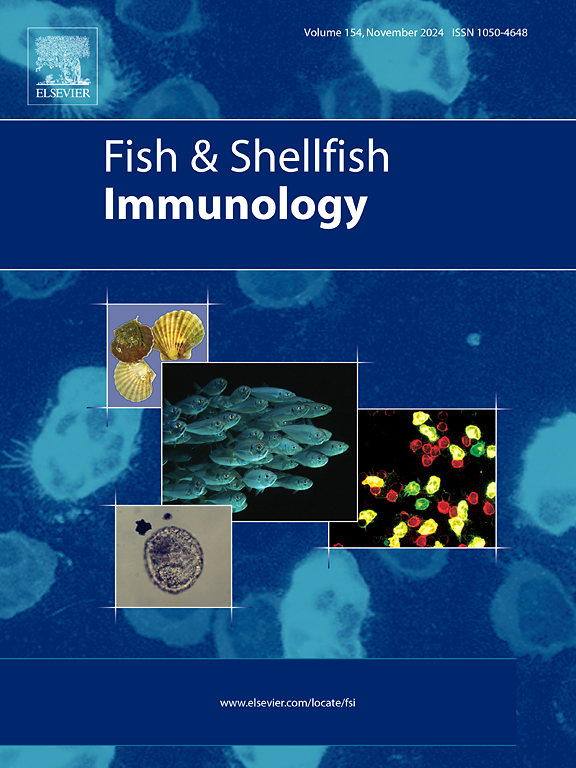驼背石斑鱼(Cromileptes altivelis)TRAF 基因家族的全基因组鉴定及其在应对 Harveyi 弧菌挑战时的表达分析
IF 4.1
2区 农林科学
Q1 FISHERIES
引用次数: 0
摘要
TRAF(肿瘤坏死因子受体相关因子)蛋白是收费样受体(TLR)和肿瘤坏死因子(TNFR)超家族中细胞信号和免疫调节信号转导的关键介质。尽管 TRAF 基因在远洋鱼类先天性免疫中非常重要,但对其在 C. altivelis 中功能的研究却很有限。本研究利用生物信息学方法鉴定并命名了八种TRAF基因(CaTRAF2a、CaTRAF2a-like、CaTRAF2b、CaTRAF3、CaTRAF4a、CaTRAF5、CaTRAF6和CaTRAF7)。系统进化、同源进化和分子进化显示,所有 CaTRAF 成员在远洋鱼类中都是进化保守的。结构域分析表明,所有 CaTRAF 蛋白都有一个保守的 N 端 RING 手指结构域。大多数 CaTRAF 蛋白的 C 端都有一个 MATH 结构域,只有 CaTRAF7 蛋白例外,它含有七个重复的 WD40 结构域。此外,还利用 qRT-PCR 技术检测了健康鱼类九种不同组织和八个不同胚胎发育阶段的表达模式,发现各成员之间存在空间和组织特异性。HE 染色显示了 V. harveyi 感染后组织的明显病变。在鳃中观察到鳃片萎缩和明显弯曲,在肝脏中观察到细胞形状不规则、脂肪空泡增多和细胞体积增大。肠道组织的肌肉层增厚,肠绒毛拉长,皱褶增多。此外,感染 V. harveyi 后,TRAF 基因的表达发生了显著变化。这些结果将有助于阐明 CaTRAF 基因在调控 C. altivelis 的免疫和炎症反应中的分子作用。本文章由计算机程序翻译,如有差异,请以英文原文为准。
Genome-wide identification of the TRAF gene family in humpback grouper (Cromileptes altivelis) and analysis of their expression in response to Vibrio harveyi challenge
TRAF (Tumor necrosis factor receptor-associated factor) proteins are key mediators of signal transduction in cell signaling and immune regulation within the toll-like receptor (TLR) and tumor necrosis factor (TNFR) superfamily. Despite the importance of TRAF genes in teleost innate immunity, study on their functions in C. altivelis is limited. This study utilized bioinformatics methods to identify and named eight TRAF genes (CaTRAF2a, CaTRAF2a-like, CaTRAF2b, CaTRAF3, CaTRAF4a, CaTRAF5, CaTRAF6 and CaTRAF7) in C. altivelis. Phylogenetic, syntenic and molecular evolution revealed that all CaTRAF members were evolutionarily conserved in teleost. Domain analysis indicated the presence of a conserved N-terminal RING finger domain in all CaTRAF proteins. Most CaTRAF proteins also featured a MATH domain at the C-terminal, with the exception of CaTRAF7 which contained seven repeat WD40 domains. In addition, qRT-PCR was used to detect the expression patterns of nine different tissues and eight different embryonic development stages of healthy fish, and it was found that there were spatial and tissue specificities among the members. HE staining revealed evident pathological lesions in the tissues post V. harveyi infection. Atrophy and significant bending of the gill lamellae were observed in the gills, while irregular cell shapes, increased fat vacuoles, and enlarged cell volume were noted in the liver. Intestinal tissues displayed thickening of the muscle layer, elongation of intestinal villi, and increased folds. Moreover, the expression of TRAF gene changed significantly after V. harveyi infection. These results would help to clarify the molecular role of CaTRAF gene in the regulation of immune and inflammatory responses in C. altivelis.
求助全文
通过发布文献求助,成功后即可免费获取论文全文。
去求助
来源期刊

Fish & shellfish immunology
农林科学-海洋与淡水生物学
CiteScore
7.50
自引率
19.10%
发文量
750
审稿时长
68 days
期刊介绍:
Fish and Shellfish Immunology rapidly publishes high-quality, peer-refereed contributions in the expanding fields of fish and shellfish immunology. It presents studies on the basic mechanisms of both the specific and non-specific defense systems, the cells, tissues, and humoral factors involved, their dependence on environmental and intrinsic factors, response to pathogens, response to vaccination, and applied studies on the development of specific vaccines for use in the aquaculture industry.
 求助内容:
求助内容: 应助结果提醒方式:
应助结果提醒方式:


